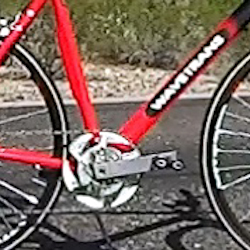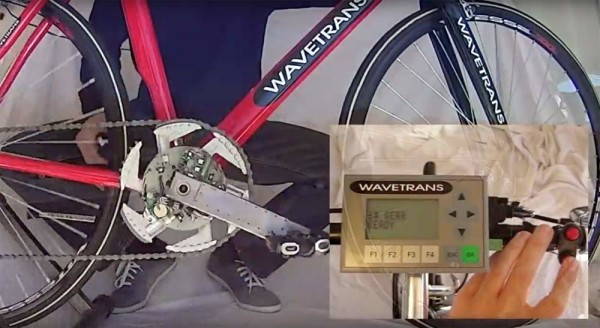If you’ve ever driven a snowmobile or a car equipped with a CVT transmission, you’ll know how smooth the engines feel as they shuffle through their “gears”. With the creation of the Wavetrans bicycle transmission, that kind of smoothness could find its way onto your bicycle.
The Wavetrans is an electronically controlled drivetrain with a single front ring that expands or contracts to provide the equivalent of six different gears. The innovative concept claims to offer several benefits versus traditional derailleur setups. It provides a seamless feeling while you shift, can be shifted under load, operates quietly and smoothly, won’t double shift like derailleurs can, digitally displays what gear you’re in, and the inventor claims the chain will never fall off.
Currently only one prototype exists and actual production is a ways off, but it’s certainly an interesting idea. Video and more details below…
The Wavetrans’ single front chain ring is made of six separate sections that telescopically expand and contract to provide six different gears. The system is electronically controlled by a programmable logic controller (PLC) and a microprocessor. While the prototype is powered by nine AA batteries which provide about nine hours of juice, production models will likely house a few less.
Riders shift gears by using two buttons on the handlebar mounted control/display unit, one to shift up and one to shift down. The buttons will always be easy to press, whereas regular shifters can require some effort to overcome cable tension, friction or spring force.
The Wavetrans system cannot be used with a regular cassette and derailleur setup in the rear, so the cassette is replaced by a single cog with a sizeable looking chain tensioner. The standpoint of the inventor, Phoenix, Arizona’s Oliver Knittel, is that most riders don’t use every gear on their bike so six should provide an adequate range.
The range provided by the prototype model is equivalent to a 47t front ring matched to a 15-24t six speed cassette, but that can be adjusted up or down. With only six intervals the Wavetrans certainly won’t achieve the same spread as a traditional drivetrain, so riding in hillier terrain might be a bit challenging.

The concept puts forth several perceived benefits: It provides a seamless pedalling feel through gear changes, the capability to shift anytime, it runs quietly, includes a digital gear indicator, and apparently offers very reliable chain retention. However, there are of course several caveats. Firstly, internally geared hubs can also be shifted anytime and some offer more gear range. Also, other brands’ electronic derailleur systems display your current gear digitally, so that’s nothing new.
Also, the Wavetrans was designed for on-road riding only, and it’s not hard to see why. Durability for trail use is dubious, with a large six-piece front ring that can’t accommodate a bash guard. You don’t gain any additional clearance in the rear with the chain tensioner hanging down just like a derailleur, and perhaps most importantly the moving front ring segments are not recommended for use in muddy conditions (but should be able to handle rain and snow…we’re thinking it makes sense for commuter bikes). If you do damage or wear out the ring pieces, replacing them isn’t a complicated task.
The prototype transmission unit itself weighs 1200g, but the inventor notes that weight was not a priority in creating the first working iteration seen here. Keep in mind the Wavetrans does eliminate the weight of two derailleurs, a rear cassette and multiple front rings.
We assume a production version would look far nicer than this simple ‘proof of concept’ prototype, in fact the rather large display/control unit is already slated to shrink in size. While the price is yet undetermined, Knittel says it should be within reason.
Further options and innovations will likely come along if production moves forward. Knittel is already working on a seven speed version, and has suggested an option for smartphone control connectivity. Knittel has filed a patent for the design and is currently seeking a partner or buyer for the Wavetrans.


